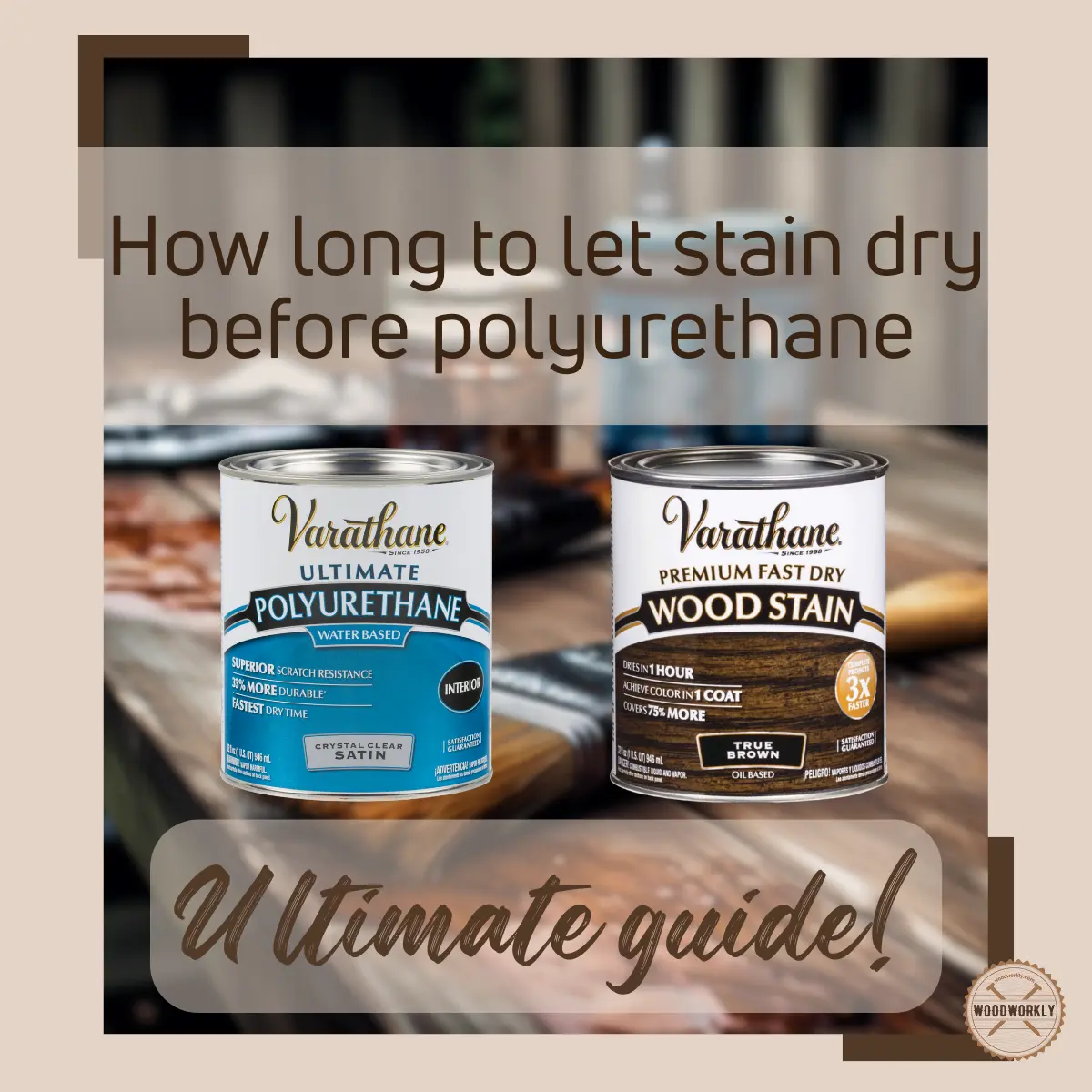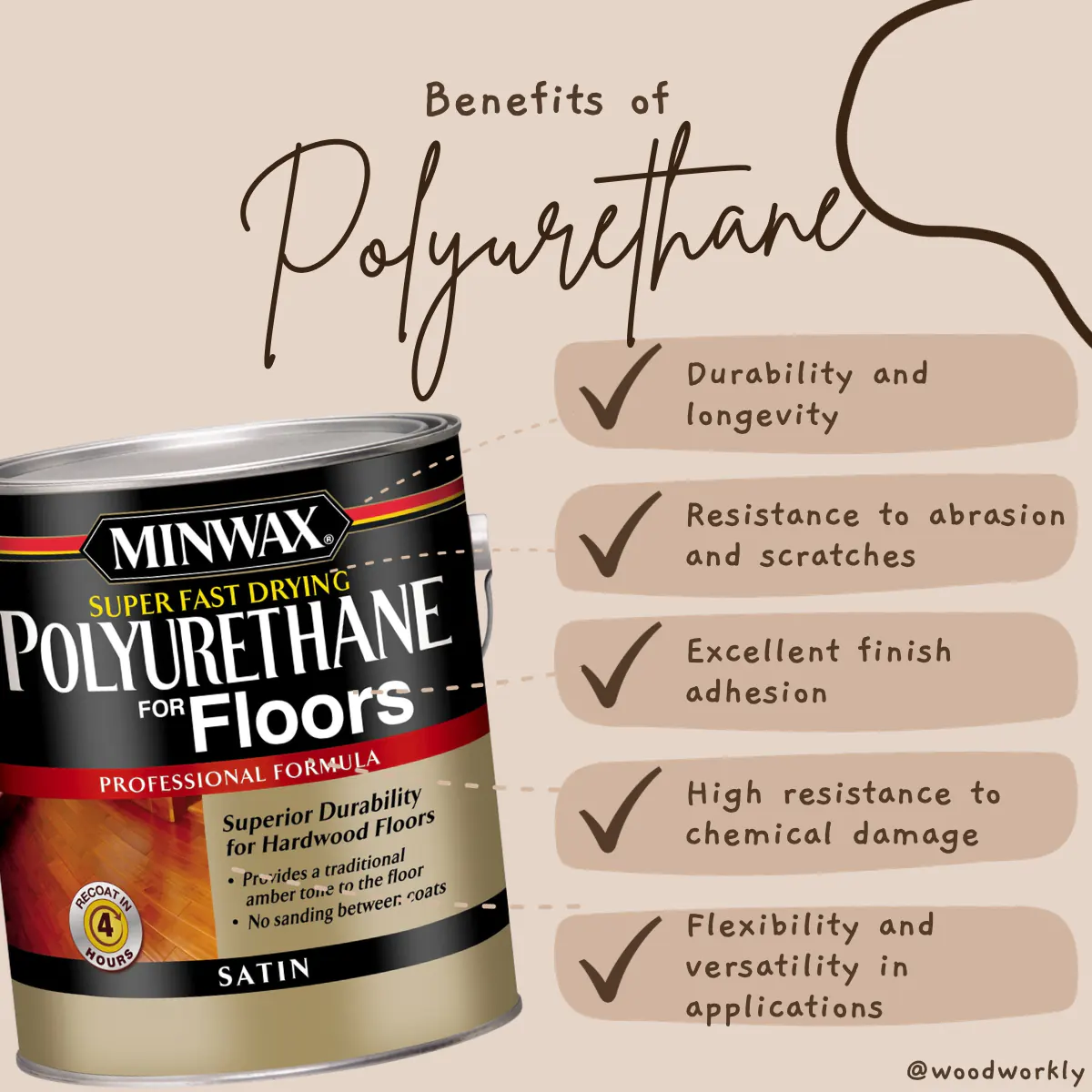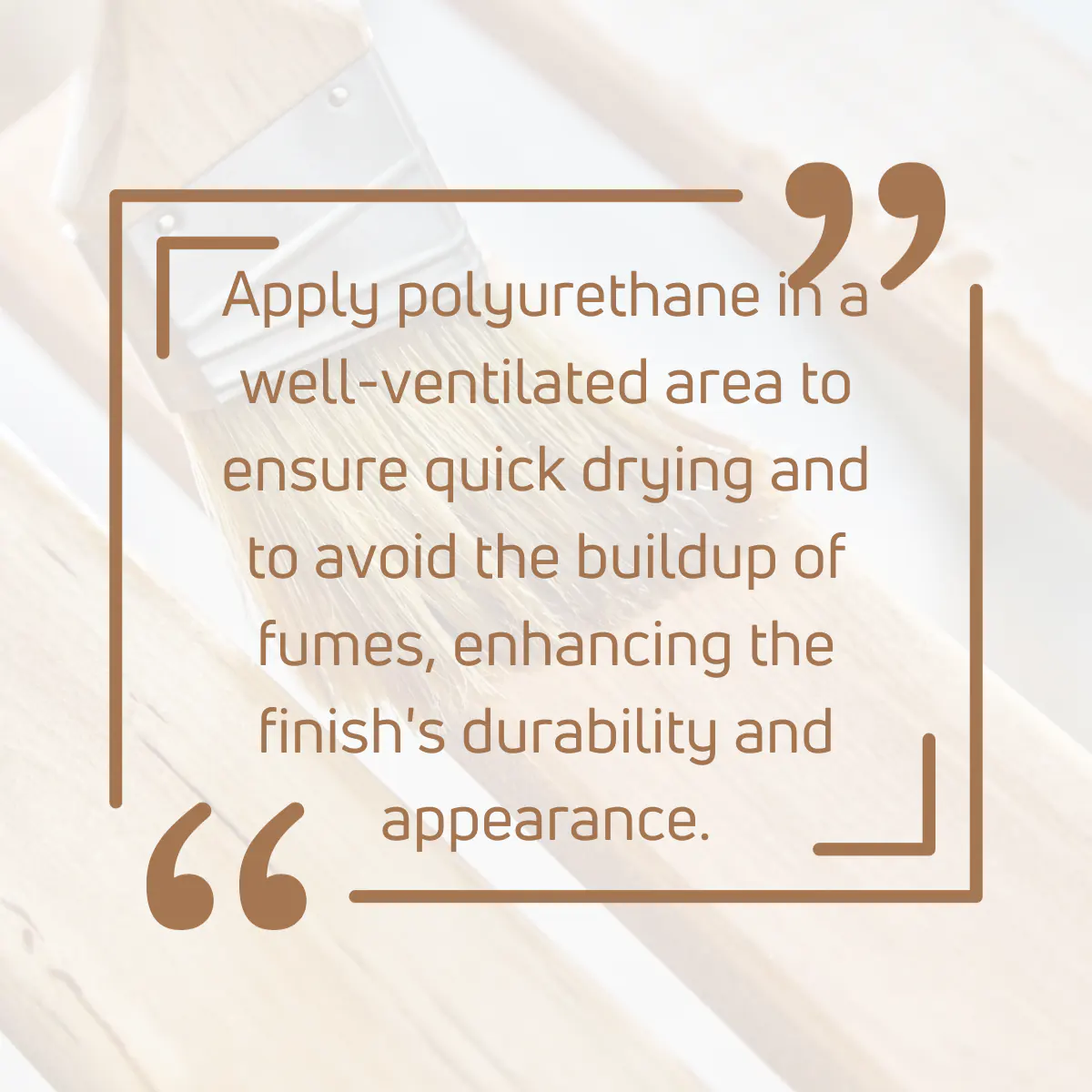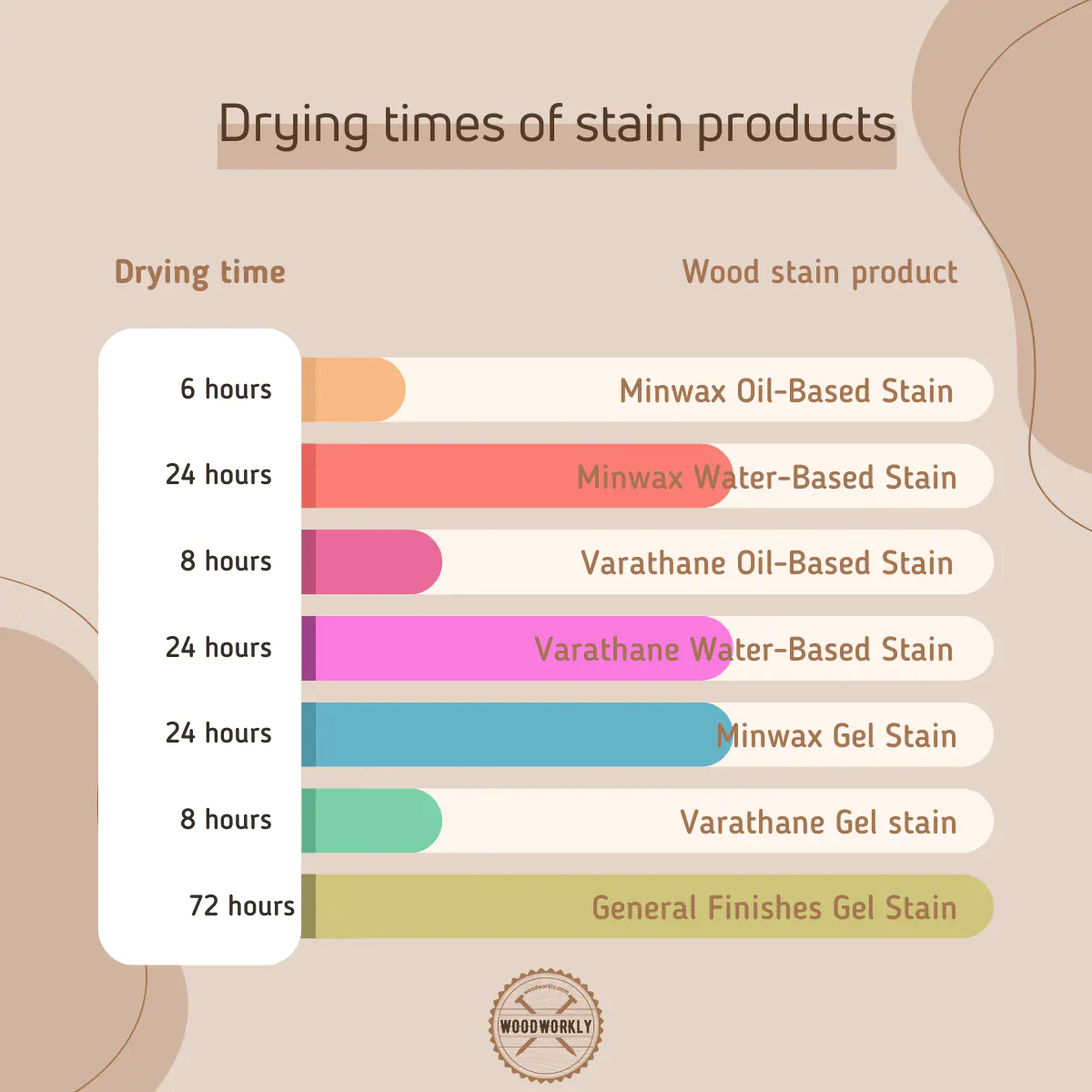Ever stained wood and wondered how long to wait before applying polyurethane? Timing is crucial for a flawless finish! Let’s unravel this mystery together.

Did you know that starting a wood staining project requires patience, precision, and an understanding of complex processes?
One of the most critical points is knowing how long you should leave the newly stained surface to dry before applying the polyurethane for extra protection from environmental elements.
When I was learning about wood finishing skills, I did a deep research about this and practiced so many projects with the help of experts to find answers for that.
Now with years of experience, I exactly how long you need to wait to gain promising results from athe polyurethane finish.

So, let’s discuss, How long to let stain dry before polyurethane?
Let the stain dry for at least 24 hours before applying polyurethane. Ensure the stain is completely dry by performing visual and tactile checks. Follow the manufacturer’s guidelines for optimal results in your woodworking project.
Now don’t think that you are fully aware of this, there are many more things that you need to know.
Today I’ll explore the differences between water-based and oil-based stains for applying over stained surfaces, delving into the nuances of stain drying times, in this detailed guide.
Whether you’re a seasoned woodworker or a DIY enthusiast, this article is the resource you need to master the art of staining and sealing wood surfaces.
Let the journey begin!

How Long Does Stain Take To Dry?
Generally, the drying time of the stain is 12-24 hours. But for some stains, it can be extended from 1 to 3 days, depending on their specific properties.
For example, lacquer-based products such as Minwax Wood Finish require a full 24 hours to dry completely.
The drying time of the stain depends on the following factors,
- Stain type
- Type of wood used
- Materials used
- Staining methods Veda
- Environmental conditions
In particular, wood type and condition are critical factors affecting drying time. Different woods absorb stains at different rates, affecting the overall drying process.
Also, the amount of stain applied and environmental conditions can significantly affect drying time, especially if done outdoors.
When you’re dealing with specific surfaces like floors, darker colors can be ready for a top coat overnight, while lighter shades like pastels may require a drying time of at least 12 hours.

How Long Does Water-Based Stain Take To Dry Before Polyurethane?
In general, water-based stains usually dry within 1-2 hours, and they are ready for the first layer of polyurethane in approximately 3 hours.
Even though water-based stain and oil-based polyurethane don’t mix, you can apply polyurethane over the water-based stain layer once the stain layer is fully dried and cured.
However, you should be aware when working those external factors such as weather conditions and application conditions can affect this time frame.
Also, different color stains can dry at slightly different speeds, and the effect on drying time is usually minimal, delaying it by only an hour or two.
Did you know that the thinner consistency of water-based stains causes them to dry faster compared to oil-based stains?
However, this quick drying time does not negate the need to be careful when preparing the surface for polyurethane application, as excessive pressure during sanding can still affect the stain.

How Long Does Oil-Based Stain Take To Dry Before Polyurethane?
Oil-based stains, on the other hand, require more time to dry, typically ranging from 6 to 24 hours, with optimal drying occurring in about 8 hours under normal conditions.
If you normally use oil-based stains, I recommend waiting at least six hours before applying polyurethane.
Doing so will ensure that the stain is completely dry and will not interfere with the application of the polyurethane.
In some cases, it is advisable to allow an oil-based stain a full 24 hours to dry, especially given its thick consistency.
This extra time provides a buffer against potential mistakes, such as applying polyurethane too quickly, which can lead to time-consuming corrections.
An important thing you should be aware of is that drying times can vary based on brand and product specifications, so erring on the side of caution by allowing more time is a prudent approach.
Based on my experience I suggest that it is usually safe to apply polyurethane a few days after staining, it gives you a more secure base for the finishing process.

Why Does Oil-Based Wood Stain Take Longer to Dry?
Although you may not realize it, oil-based wood stain takes longer to dry due to its higher viscosity.
As the thickness of the stain increases, it becomes more challenging to efficiently penetrate the product’s wood pores.
Did you know that this slow penetration is a major factor contributing to long drying times?
Also, you should be aware that the composition of the oil-based stain plays a critical role in determining how long it takes to dry.

Also, the inherent properties of the stain, such as the type of solvents and additives you use, affect the drying process.
Additionally, keep in mind that external factors such as the temperature and humidity of the drying environment have a significant effect on drying time.
High humidity levels and low temperatures can hinder the solvent evaporation process, further extending the time it takes for the stain to dry.
While there are quick-drying oil-based stains on the market, they often sacrifice durability. These products are usually thinner, leading to faster drying times but at the expense of a stronger and longer-lasting finish.
You should be aware that the application method also affects the drying time. If you use a brush or roller, there is a greater risk of applying too much stain, which requires a longer drying time.
On the other hand, if the user is skilled in using the tool effectively, applying the stain with a sprayer can reduce this risk.

Factors that Affect the Drying Time of Stain
There are several factors that affect the drying time of stains.
Therefore, in order to achieve optimal results in any staining project, you must have a good understanding of the factors I will mention below.
Stain Composition
Did you know that the composition of the stain is a significant determinant of drying time?
For example, oil-based stains are more viscous than water-based stains.
Generally, the thickness of the stain affects how quickly it can penetrate the wood or other surface, affecting the overall drying process.
Environmental Conditions
You must be aware that environmental conditions play an important role in the staining process.
The temperature and humidity level of the application area affect how quickly the solvent in the stain evaporates.
High humidity can slow down the drying process, while hot temperatures usually speed it up.
Type of Staining
Did you know that there are different types of stains and different formulations for them?
For example, oil-based stains are usually thicker, contain more volatile solvents, and can take longer to dry than water-based stains.
So keep in mind that the drying time will vary depending on the type of stain you use.

Type of Wood
The type of wood stained is another crucial factor. In general, different woods have different levels of porosity, which affect how well the stain absorbs.
Hardwoods may take longer to absorb the stain than softwoods, which affects the overall drying time.
Thickness of Application
The thickness of the stain layer you apply is another factor that affects drying time.
Thicker or heavier applications take longer to dry because there is more material to undergo the drying and curing process.
Mode of Application
The method you use to apply the stain affects the drying time. Brushing or rolling over the stain will result in a thicker layer, thus slowing drying in such cases.
Conversely, spot spraying can lead to a more even application with less risk of over-application.

Stain Color and Pigment Concentration
Did you know that stain color is affected by drying time?
Darker stains often contain more pigments or dyes, which affect how quickly they bond to the wood.
Additionally, the concentration of pigment in the stain contributes to the overall drying process.
Ventilation
In some cases, insufficient ventilation can prevent solvent vapors from dispersing, interfering with the drying process.
Proper airflow helps carry this vapor away, promoting faster drying.
Wood Surface Preparation
The condition of your wood surface before staining is very important.
Remember that if the wood is too wet or not properly cleaned and prepared, it will slow down the absorption of the stain and prolong the drying time.
Special Stains and Additives
Did you know that some stains come with special additives or properties that change their drying characteristics?
Certain stains, such as those designed to be distressed or with long open times, may take longer to dry naturally.
So, understanding the factors I mentioned above allows for better control and management of the staining process.
Ensure that the stain you choose will work effectively in specific conditions and that the drying time will align with the project requirements.

How to Know Wood Stain Is Dried Enough for Polyurethane?
By making sure that the wood stain is sufficiently dry before you apply polyurethane, you can ensure that your finish is smooth and durable.
Applying polyurethane inadvertently or too quickly can disrupt the stain, leading to problems such as uneven color or adhesion problems.
Several visual and tactile indicators help ensure that the wood stain is sufficiently dry before applying polyurethane.
I will now tell you some important things to check if the wood stain is dry enough for the polyurethane.
1. Visual Inspection
A simple way you can do this is to visually inspect the surface of the stain. The stain changes color as it dries.
Here you first look for a consistent matte look over the entire area.
Remember that if the stain is still shiny or wet at this point, it indicates that the solvent has not completely evaporated and the stain is not ready for the next coat.
2. Tangential Assessment
In this method, you gently touch the stained surface with a clean and dry finger.
If the spot feels cool or hard here, it’s a sign that the drying process is underway.
On the contrary, a dry and smooth feeling indicates that the stain is sufficiently dry, and the wood is ready for polyurethane.
3. Check the Smell
Generally, freshly applied stain emits a distinct odor due to the solvents present. When the stain is completely dry, this smell will decrease.
If you can still detect a strong smell, it indicates that the solution has not completely evaporated, and the stain needs more time to dry.
4. Observe Color Changes
Wood stain often darkens as it dries.
If you see a significant change in color from the wet to dry state and the color has stabilized, it is an indication that the stain has reached the point where it is ready for the next step in the refinishing process.
5. Follow the Manufacturer’s Instructions
Always refer to the manufacturer’s guidelines and recommendations for the specific stain product you are using.
You may find that the manufacturer provides instructions on the correct drying time and conditions.
Following these guidelines will ensure that you are working within the parameters set by the stain manufacturer.

6. Tape Test
Place a small piece of painter’s tape on the stained surface and press it firmly. Gently peel off the tape.
If the tape pulls up on the stain or feels sticky, the stain is not yet dry. If the tape comes out clean, that’s a good indicator that the stain has dried sufficiently.
7. Allowance of Time
Time frames may vary depending on the type of stain and environmental conditions, but a general rule of thumb is to wait at least 24 hours before applying polyurethane.
This provides enough of a buffer, especially in less-than-ideal conditions, to ensure that the stain has enough time to dry.
By combining these visual, tactile, and time-related assessments, you can confidently determine when a wood stain is dry enough to apply polyurethane, ensuring a successful and long-lasting finish.
If you’re willing to apply using a sprayer, read to know how to thin polyurethane for spraying.

How to Make Stain Dry Faster?
When working on a project with time constraints or under less-than-ideal conditions, you have to employ strategies to speed up the drying time of the wood stain.
Here it is important not to compromise the quality of the finish, and implementing certain techniques can help speed up the drying process without sacrificing the overall integrity of the stain.
I will now share with you the techniques I use to get the stain to dry normally.
1. Optimal Environmental Conditions
Ensure that the work area is well-ventilated with adequate ventilation. Warm temperatures and low humidity levels promote rapid solvent evaporation, facilitating rapid drying.
If possible, I advise you to use fans and open windows to improve ventilation.
2. Choose a Quick Drying Stain
Opt for wood stains specifically labeled as quick drying. These formulas are designed with solvents that evaporate more quickly, reducing overall drying time.
Remember to follow the manufacturer’s directions for application and drying.
3. Thinner Applications
Always apply the stain thinly and evenly. Thicker applications take longer to dry because there is more material to evaporate.
Using a clean, lint-free cloth or sponge applicator will help achieve a more controllable and thinner application.
4. Increase Air Circulation
Place additional fans or air circulation devices near the stained surface.
This speeds up the drying process by helping to disperse solvent vapors more effectively.
Avoid placing the fans too close or this may interfere with the application of the stain.
5. Use a Heat Source
Gently introduce heat to the stained surface using heat lamps or infrared heaters. This can speed up the drying process, especially in cooler conditions.
However, be careful to avoid overheating, which can cause other problems such as bubbling or uneven drying.
By combining these strategies, you can speed up wood stain drying time while maintaining the quality and integrity of the finish.
I advise you to always follow the product instructions and guidelines to ensure successful and satisfactory results.

Tips for Applying Polyurethane Over Stain
I’ll share with you some tips I use to apply polyurethane over stains.
- Make sure the stain is completely dry by waiting at least 24 hours after staining.
- Light sanding between coats of polyurethane promotes better adhesion and a smoother finish, so use fine sandpaper.
- Choose a polyurethane finish that matches your desired result.
- Always invest in a high-quality brush or applicator to ensure an even application.
- Be sure to stir the polyurethane gently before application rather than shaking it vigorously.
- Avoid applying thick coats of polyurethane, which can cause drips, uneven drying and a less professional appearance. Thin, even coats are best and multiple layers can be applied for added protection and to avoid polyurethane mistakes.
- Watch out for bubbles when applying. If bubbles appear, gently brush them immediately to prevent them from drying out completely.
- Use long, even strokes when applying polyurethane. Consistency in brushing technique helps achieve an even finish and minimizes the risk of streaks or brush marks.
By following these tips, you can improve the process of applying polyurethane over the stain, resulting in a professional-looking, long-lasting finish for your wood surfaces.
That’s it folks! Now you know how long to set stain dry before polyurethane in detail with important factors and things you should look for.

So, let’s answer some frequently asked questions.
FAQs
How long should I wait before applying polyurethane over a water-based stain?
Water-based stains typically dry faster, allowing you to apply polyurethane in about 1-2 hours. However, it’s advisable to wait up to 3 hours to ensure the stain is completely dry.
Can I apply polyurethane over an oil-based stain on the same day?
It’s recommended to wait at least 24 hours to ensure oil-based stains are thoroughly dry before applying polyurethane. The drying time can vary depending on the environmental conditions and the thickness of the stain application.
How can I speed up the drying process of the wood stain?
Enhance the drying process by ensuring proper ventilation, controlling the room’s temperature, and humidity, or using artificial temperature control tools. Always refer to the stain manufacturer’s guidelines to avoid affecting the quality of the stain.
Does humidity affect the drying time of wood stains?
Yes, high humidity can prolong the drying process of wood stains. Using a dehumidifier can help control moisture levels and expedite drying time.
How do I know if the stain is dry enough for applying polyurethane?
You can employ the touch test; if the stain feels dry to touch, it’s generally ready for polyurethane. Another indicator is the absence of a strong odor, especially for oil-based stains.
Is it possible to apply water-based polyurethane over oil-based stain?
Yes, you can apply water-based polyurethane over oil-based stain, provided the stain is completely dry. Sanding the surface lightly before applying polyurethane can ensure better adhesion.
What happens if polyurethane is applied too soon over the stain?
Applying polyurethane before the stain is dry can lead to poor adhesion, and the finish may flake or peel off. It can also potentially discolor the stain, requiring a redo of the staining process.
How can I tell if an oil-based stain is dry?
Oil-based stains are considered dry when they’re no longer tacky to touch and the strong odor has dissipated, indicating the solvents have evaporated and cured.
Is it necessary to sand the wood before applying polyurethane over the stain?
Lightly sanding the stained wood can help in achieving a surface that allows better adhesion for the polyurethane, ensuring a durable and even finish.
How many coats of stain should be applied before polyurethane?
Generally, one to two coats of stain are sufficient, but it depends on the desired color intensity and the type of wood. Ensure each coat is dry before applying the next to avoid prolonged drying times or uneven finishes.
Did I cover all you wanted to know about: How Long to Let Stain Dry Before Polyurethane
In this article, I’ve deeply discussed how long to set stain dry before polyurethane for the perfect finishing with a nice appearance and extra protection from the outside world.
The time to let stain dry before applying polyurethane varies with the type of stain: water-based stains take 1-2 hours, oil-based stains require 24 hours, and gel-based stains need 8-24 hours to dry. Always check the stain’s manufacturer guidelines for specific drying times to achieve the best results.
Furthermore, I’ve answered some frequently asked questions as well.
Hope you’ve learned all you wanted to know about how long to set stain dry before polyurethane in detail including expert tips and techniques.
Now it’s time for you to practice this in real scenarios and see how much time you should let the stain dry before polyurethane. If you wait for so long, even days, and no results, sorry for telling you, man, you’ve stained wrong.
It may be because of applying many coats of stain or applying thick coats, or if your stain is super tacky and you haven’t let each stain coat dry well before applying another. You cannot apply polyurethane over tacky stain.
Make sure to minimize wood stain mistakes for fast and efficient drying of your stain coat. Happy wood finishing with polyurethane!